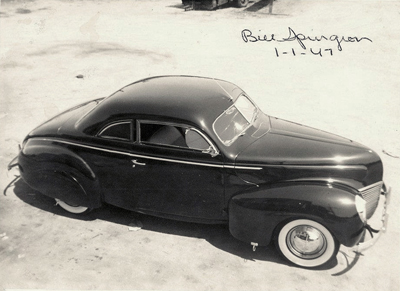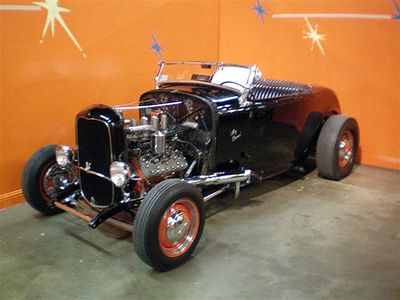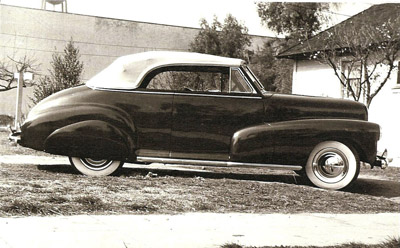1940s
















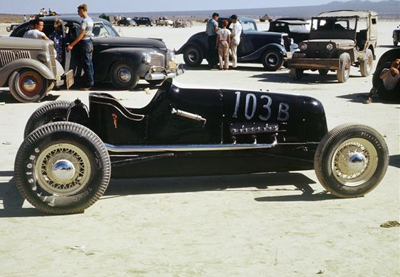










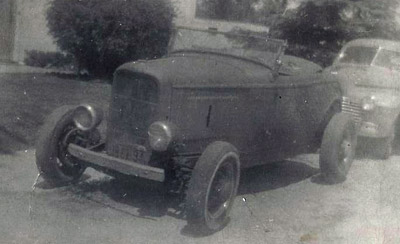































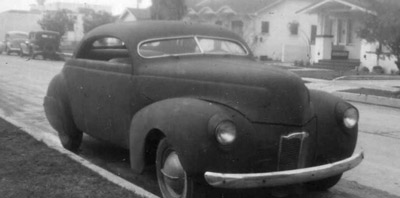






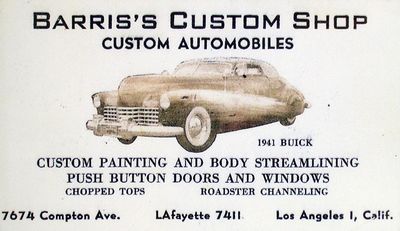








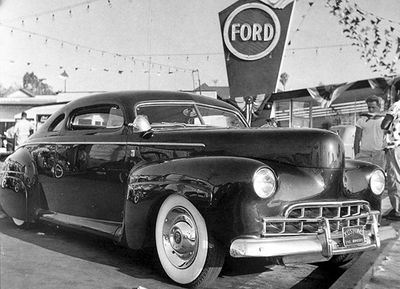






































<-- 1930s - 1940 - 1941 - 1942 - 1943 - 1944 - 1945 - 1946 - 1947 - 1948 - 1949 - 1950s -->
The 1940s marked a period of economic growth and booming consumer spending, particularly after World War II. The revival of the economy allowed people to focus on more than just basic necessities, fueling a surge in recreational activities such as auto racing and customization. In Southern California, track roadster racing and hot rodding gained immense popularity, with new venues and innovations reshaping the post-war automotive culture.[1]
Contents
- 1 Custom Cars and the Rise of Customizing
- 2 Pioneering Customizers of the 1940s
- 3 Popular Custom Modifications of the 1940s
- 3.1 Chopped Tops
- 3.2 Channeled Bodies
- 3.3 Inset License Plates
- 3.4 Frenched Headlights
- 3.5 Shaved Trim
- 3.6 Solid Hood Sides
- 3.7 Removed Running Boards
- 3.8 Fender Skirts
- 3.9 Custom Bumpers
- 3.10 Spotlights
- 3.11 Cowl-Antenna]
- 3.12 Push-Button-Operated Doors
- 3.13 Custom Hubcaps
- 3.14 Custom Grilles
- 3.15 Lowered Suspensions
- 3.16 Carson Tops
- 4 Impact of World War II on Custom Car Culture
- 5 The Post-War Boom and the Lead Sled Era
- 6 Bill Burke and the First Belly Tank Streamliner
- 7 The Hot Rod Fever Hits the Midwest
- 8 Hot Rods of the 1940s
- 9 Modifieds of the 1940s
- 10 Streamliners of the 1940s
- 11 Custom Cars of the 1940s
- 12 Custom Trucks of the 1940s
- 13 Sport Customs of the 1940s
- 14 Sport Cars of the 1940s
- 15 Homebuilt Cars of the 1940s
- 16 Custom Car Builders and Fabricators of the 1940s
- 17 Custom, Body, and Repair Shops of the 1940s
- 18 Upholstery Shops of the 1940s
- 19 Speed Shops of the 1940s
- 20 Hot Rod and Custom Auto Lots of the 1940s
- 21 Hot Rod and Custom Car Clubs of the 1940s
- 22 Speed Equipment Manufacturers of the 1940s
- 23 Custom Accessory Manufacturers of the 1940s
- 24 Racing and Timing Association of the 1940s
- 25 References
Custom Cars and the Rise of Customizing
The 1940s marked a significant turning point in the evolution of custom cars, as the practice of modifying automobiles for aesthetic and performance purposes transitioned from a niche hobby into a full-fledged cultural movement. While the 1930s had laid the groundwork, primarily with luxury coachbuilt customs and grassroots "restyled jobs," the 1940s saw a rapid expansion of customization techniques and the establishment of influential builders who would shape the industry. Figures like Jimmy Summers, Harry Westergard, George Barris, and Bill Hines pioneered key modifications such as chopped tops, shaved trim, fadeaway fenders, and the use of lead for seamless bodywork, setting the stage for the golden age of customs in the following decade.
Customizing in the early 1940s was still an underground practice, primarily concentrated in California, where warm weather and a thriving car culture provided the ideal environment for experimentation. While early custom cars were often modified for aesthetics, they also incorporated elements from race cars, hot rods, and European luxury automobiles.
During this period, automobile manufacturing was halted in 1942 due to the United States' entry into World War II, and materials such as steel, rubber, and fuel were rationed. As a result, car enthusiasts had to rely on modifying older vehicles rather than purchasing new ones. Many returning servicemen, trained in welding, machining, and bodywork, applied their technical skills to automobile customization, fueling a post-war boom in the custom car scene.
Pioneering Customizers of the 1940s
Jimmy Summers
Considered by many to be one of the first professional customizers, Jimmy Summers operated Jimmy Summers Custom Automobile Body Shop at 7919 Melrose Avenue, Los Angeles, throughout the late 1930s and 1940s. His shop was located across from Fairfax High School, where students such as Alex Xydias would watch him work.
Summers was known for his chopped tops, channeled bodies, recessed license plates, frenched headlights, and seamless body modifications that predated many of the factory design trends of the 1950s. Unlike the more radical customizers who followed him, Summers focused on subtle refinements that made stock cars look smoother and more sophisticated.
His work gained recognition among early hot rodders and car enthusiasts, and his techniques helped standardize many of the fundamental modifications that would define kustom kulture.
Harry Westergard
While Summers operated in Los Angeles, Harry Westergard was developing his own unique approach to customizing in Sacramento, California. Working from a garage on Fulton Avenue, Westergard modified cars for local racers and street enthusiasts, often using salvaged parts from high-end luxury automobiles.
Westergard's signature touches included, chopped tops, custom grilles often sourced from LaSalle and Packard models, molded fenders, fadeaway fenders, lowered suspension, smoothed and reshaped body lines.
He was particularly influential in the early Mercury custom scene, setting the groundwork for what would later be known as "lead sleds." Many of his styling cues were adopted and expanded upon by George Barris and Sam Barris in the late 1940s and early 1950s.
George Barris and Sam Barris
One of the most influential figures in custom car history, George Barris, began his career in Roseville, California, where he learned metal shaping and bodywork. George honed his craft under Harry Westergard before moving to Los Angeles in 1942.
In 1944, Barris opened a small shop on Imperial Highway in Bell, California, officially establishing what would become Barris Kustoms. The details of exactly how Sam Barris joined the business vary depending on the source. According to a 1953 Hop Up article, Sam looked up his long-lost brother after the war, and the two sat down to reminisce about old times. As they laughed about a Buick they had restyled up in Roseville, George suddenly had an idea. "Hey, man, I've got an idea. Let's go into the custom business together!" Sam wasn’t convinced. "I don’t know the first thing about bodywork," he reminded George. But George had confidence in his brother. He started teaching Sam the tricks of the trade and, after a few weeks, decided he was good enough to pass as a bodyman. The brothers pooled their resources and rented a small shop on Imperial Avenue in Los Angeles in 1946. By the late 1940s, Barris had gained national recognition for their radical body modifications, custom paint techniques, and signature styling elements. Their work was prominently featured in the first Hot Rod Exposition Show in 1948, helping to legitimize custom cars as a distinct automotive art form.
Popular Custom Modifications of the 1940s
The 1940s was the decade when signature custom modifications became standard practice. Customizers were perfecting the art of chopping tops, sectioning bodies, and molding body panels to create smoother, more flowing lines. Some of the most popular modifications of the time included:
Chopped Tops
Lowering the roofline of a car for a sleeker, more aggressive stance. One of the most dramatic and defining modifications of the 1940s. Popular among both hot rodders and customizers, a well-executed chop could turn an ordinary sedan into a sinister boulevard cruiser or give a convertible a low, road-hugging profile when paired with a padded Carson-style top.
Channeled Bodies
Also known as “body dropping,” this modification involved lowering the body over the frame rails to achieve a lower stance without altering the roofline. By cutting the floor and raising it higher around the frame, customizers could make a car sit dramatically lower, giving it a ground-hugging, streamlined look. Channeled bodies were popular among both early hot rodders and customizers, who favored a low, aggressive profile that emphasized speed and style.
Inset License Plates
This feature marked the "California Car" back in the early days of customizing. By recessing the license plate into the deck lid or rear pan, builders achieved a cleaner, more integrated look. Eliminating bulky brackets and exposed mounts, inset plates helped create the smooth, flowing lines that became a defining trait of early West Coast Customs.
Frenched Headlights
A signature custom touch born in the 1940s, this modification involved recessing the headlights into the fenders for a flush, integrated look. By eliminating factory bezels and blending the lights into the body, customizers gave their cars a refined, futuristic appearance that remained popular for decades.
Shaved Trim
One of the simplest yet most effective ways to refine a custom car’s appearance. By removing factory badges, door handles, and excess chrome, builders achieved a smooth, uninterrupted look that emphasized the car’s body lines. Often paired with hidden door poppers, this modification gave customs a sleek, almost futuristic presence on the street.
Solid Hood Sides
A classic pre-war custom trick that carried into the 1940s, replacing factory-vented hood sides with smooth, solid panels gave cars a more refined and seamless look.
Removed Running Boards
A popular modification that gave cars a lower, more streamlined profile. By eliminating the running boards and extending the rocker panels, customizers created a sleeker, more upscale appearance reminiscent of high-end coachbuilt cars. This simple yet effective change made early customs look more modern and refined.
Fender Skirts
A signature custom touch that enhanced a car’s flowing lines by covering the rear wheel openings. Inspired by luxury cars of the era, skirts gave customs a smooth look, making them appear lower and more refined. Often paired with lowered suspensions and wide whitewall tires for maximum effect.
Custom Bumpers
Swapping out factory bumpers for more stylish alternatives was a popular way to personalize a custom. Ripple bumpers and 1940 Oldsmobile bumpers were among the favorites, adding a touch of elegance or a more aggressive stance.
Spotlights
A popular accessory that added both style and function, spotlights became a staple of 1940s customs. Often mounted in pairs on the A-pillars, they gave cars a high-end, almost factory-luxury look. Appleton spotlights were the gold standard, prized for their sleek design and ability to swivel, though most were installed purely for style rather than function.
Cowl-Antenna]
A subtle but stylish modification, relocating the antenna to the cowl kept the car’s lines clean while maintaining functionality.
Push-Button-Operated Doors
A high-tech touch for the 1940s, replacing traditional door handles with hidden push-button mechanisms, gave customs a sleek, futuristic look. This modification not only enhanced the car’s smooth, uninterrupted lines but also added an element of mystery and sophistication.
Custom Hubcaps
A must-have accessory in the 1940s, custom hubcaps added flair and individuality to any build. Single-flipper hubcaps were a popular choice.
Custom Grilles
Swapping out stock grilles for more elaborate designs was a signature touch of 1940s customs. Builders often borrowed from Cadillac, LaSalle, or Packard to create a more upscale, distinctive front end. A well-chosen grille could completely transform a car’s personality, giving it a luxurious or aggressive look.
Lowered Suspensions
A key element of the early custom look, lowering a car’s suspension gave it a sleeker, road-hugging stance. This was often achieved by de-arching the leaf springs, a simple but effective method to bring the body closer to the ground. A lower ride height enhanced the car’s streamlined appearance and set it apart from stock models.
Carson Tops
Developed by Amos Carson and perfected by Glen Houser at Carson Top Shop, the Carson Top was a non-folding, padded convertible roof that gave cars a luxurious, sleek profile. It became a defining feature of high-end customs in the 1940s.
Impact of World War II on Custom Car Culture
The outbreak of World War II temporarily halted the progress of the custom car movement as material shortages, fuel rationing, and restrictions on civilian car production made it difficult for enthusiasts to modify or even maintain their vehicles. However, the war had an unintended positive impact on the industry. Many young servicemen received extensive training in welding, machining, and fabrication—skills that would later prove invaluable in car customization. Exposure to European sports cars and racing culture further influenced their tastes and ideas, introducing new design concepts that would shape the post-war era. When the war ended, a booming economy provided returning veterans with disposable income, allowing them to invest in automobiles and modifications. This combination of technical expertise, fresh inspiration, and financial means led to a resurgence in car culture, laying the groundwork for the explosive growth of the custom car scene in the late 1940s and beyond.
The Post-War Boom and the Lead Sled Era
By the end of the 1940s, the custom car scene was experiencing unprecedented growth. The return of automobile production in 1946 meant newer cars were available for modification. By 1950, the supply was catching up with demand, and prices quickly began to fall. According to Albert Drake, a complete Model A could be had for as little as $5-20 in the late 1940s, "although the average price was somewhere around $75."[2]
The Barris Brothers, the Ayala Brothers, and Valley Custom Shop rose to prominence in the late 1940s, each bringing their own unique style to the movement. Meanwhile, the first car shows and automotive magazines dedicated to customs began appearing, solidifying the genre’s place in American car culture.
Bill Burke and the First Belly Tank Streamliner
Bill Burke's P-51 Belly Tank is known as the first Belly Tank Streamliner racer. Bill was racing on the dry lakes long before the war started. While stationed in the South Pacific during WWII he saw potential in using a belly tank as the body for a dry lakes car. Shortly after returning home from the war he built his first Belly Tank Streamliner. In 1946 he raced his brand new car. Burke was the first to run a belly tank in the "Streamliner" class and ran at both El Mirage and Harper Dry Lake. The first Bill Burke streamliner used a small 165-gallon steel wing tank from a P-51 Mustang. The car was a front engine design, and a bicycle seat was welded to the torque tube for driving.[3]
The Hot Rod Fever Hits the Midwest
By 1948, hot rod culture was no longer just a California phenomenon. Across the country, returning GIs, young mechanics, and garage tinkerers were embracing the thrill of speed, performance, and personal style. In April of 1948, The Kansas City Star published one of the earliest and most vivid newspaper features on hot rodding in the Midwest. The article offered a time-correct glimpse into the booming scene in Kansas City, Missouri, where the hot rod movement had taken root with a unique regional flavor.[4]
Written by journalist Hughes Rudd, the article described how thousands of spectators gathered at a makeshift dirt track in Smithville, just north of Kansas City, to watch local hot rodders race stripped-down, rebuilt cars. The crowd—estimated at 14,000 people—reflected just how quickly the culture was catching on outside of California.[4]
According to Rudd, a few hot rods had existed in the Kansas City area before WWII, but the movement exploded in the postwar years. By 1948, the local scene had grown so fast that it was impossible to keep track of how many hot rods were roaming the streets. Organized racing was beginning to take hold, with exhibition events drawing serious attention—and serious machinery.[4]
Hot Rods of the 1940s
George Barris' Track Roadster
The Bob Berkshire Roadster
Paul Schiefer's 1925 Ford Model T Roadster
Buddy Hinman's 1927 Chevrolet Roadster
Bob Estes' 1927 Ford Model T Roadster
Chuck Gibson's 1927 Ford Model T Roadster Pickup
Pat McNamara's 1928 Ford Model A Pick-Up
Art Tremaine's 1929 Ford Model A Roadster
Dick Courtney's 1929 Ford Model A Roadster
Eugene Pereira's 1929 Ford Model A Roadster
Fred Larsen's 1929 Ford Model A Roadster
Buddy Hinman's 1931 Ford Model A Roadster
James Stewart's 1931 Ford Model A Roadster
Bill Kelly's 1932 Ford 3-Window Coupe
Bob McGee's 1932 Ford Roadster
Dick Noble's 1932 Ford Roadster
Eugene Wentworth's 1932 Ford Roadster
Fran Bannister's 1932 Ford Roadster
Jim Papworth's 1932 Ford Roadster
Jimmy Summers' 1932 Ford Roadster
Joe B. Sheppard's 1932 Ford Roadster
Mac Schutt's 1932 Ford Roadster
Monte Monroe's 1932 Ford 3-Window Coupe
Nelson Morris' 1932 Ford Roadster
Sid Kayman's 1932 Ford Roadster
Willie Kendig's 1932 Ford Roadster
Honest Charley's 1934 Ford Sedan
Tom Hunt's 1934 Ford Roadster
Sebastian Rubbo's 1936 Ford Roadster
The Eugene Von Arx Special
Modifieds of the 1940s
Streamliners of the 1940s
Custom Cars of the 1940s
Alex Xydias' 1934 Ford Cabriolet
Sam Giberson's 1934 Ford Roadster
Bruce Brown's 1936 Ford
Frank Sandoval's 1936 Ford 3-Window Coupe
George Barris' 1936 Ford 3-Window Coupe
Jack Calori's 1936 Ford 3-Window Coupe
Joe "Bud" Simmons' 1936 Ford 3-Window Coupe
Lawrence Garrison's 1936 Ford Convertible
Leland Davis' 1936 Ford
Ray Giovannoni's 1936 Ford Roadster
Red Swanson's 1936 Ford Convertible
Robert Fulton's 1936 Ford Sedan Convertible
Tommy Jamieson's 1936 Ford 5-Window Coupe
Vern Simon's 1936 Ford Roadster
Leroy Semas' 1937 Chevrolet Coupe
Neil Emory's 1937 Dodge Convertible
Al Twitchell's 1937 Ford Sedan
Richard Emert's 1937 Ford Convertible
Richard Meade's 1938 Buick Convertible
John Sal Cocciola's 1938 Chevrolet Convertible
George Bistagne's 1938 Ford DeLuxe Convertible Sedan
Harold Johnson's 1938 Ford Tudor
Joe Stone's 1938 Ford Convertible Sedan
Norm Milne's 1938 Ford Convertible Sedan
Arthur Lellis' 1939 Ford Convertible
C. E. Johnson's 1939 Ford
Dick Bair's 1939 Ford Convertible Sedan
Emil Dietrich's 1939 Ford Convertible
G. L. Harlander's 1939 Ford V-8 Convertible Sedan
Harry O. Lutz' 1939 Ford Convertible
Harry Keiichi Nishiyama's 1939 Ford Convertible
Jack Ruynan's 1939 Ford Convertible
Jerry Moffatt's 1939 Ford Convertible
Kenny Controtto's 1939 Ford Convertible
Mel Falconer's 1939 Ford
Mickey Chiachi's 1939 Ford
Bill Henderson's 1939 Mercury Convertible
Bill Spurgeon's 1939 Mercury Coupe
Jim Kierstead's 1939 Mercury Coupe
Bob Creasman's 1940 Ford Coupe
Fred Cain's 1940 Ford Coupe
Gene Garret's 1940 Ford
Johnny Williams' 1940 Ford Coupe
Ralph Jilek's 1940 Ford Convertible
Al Andril's 1940 Mercury Coupe
Butler Rugard's 1940 Mercury
Dick Owens' 1940 Mercury Convertible
Harold Ohanesian's 1940 Mercury Convertible Sedan
Jimmy Summers' 1940 Mercury Convertible
Johnny Zaro's 1940 Mercury Coupe
Lawrence Garrison's 1940 Mercury Convertible
Maximilian King's 1940 Mercury Convertible
Eldon Gibson's 1940 Oldsmobile
Al Twitchell's 1940 Plymouth Four Door
Bill Hines' 1941 Buick Convertible
Frank Kurtis' 1941 Buick - The Kurtis Buick Special
George Barris' 1941 Buick Convertible
Pierre Paul's 1941 Buick Special
Al Lauer's 1941 Cadillac Convertible
Dick Carter's 1941 Ford Convertible
George Janich's 1941 Ford Business Coupe
Jesse Lopez' 1941 Ford Club Coupe
John Vara's 1941 Ford Convertible
Charles Kemp's 1941 Plymouth Convertible
Dean Batchelor's 1941 Pontiac
Marvin Lee's 1942 Chevrolet Fleetline
George Shugart's 1946 Chevrolet Convertible
Raymond Jones' 1947 Studebaker Convertible
Vincent E. Gardner's 1947 Studebaker Sportster
Benny Furtado's 1948 Ford Convertible
Albrecht Goertz's 1948 Studebaker Business Coupe
Marcia Campbell's 1949 Chevrolet Convertible
Custom Trucks of the 1940s
Charlie Grantham's 1935 Ford Pick Up
Sport Customs of the 1940s
Norman Timbs' Buick Special
The Rotzell 46
Robert McClure's Custom
George McLaughlin's Roadster
Sport Cars of the 1940s
Homebuilt Cars of the 1940s
Custom Car Builders and Fabricators of the 1940s
Al Ayala
Al Twitchell
Bill Hines
Gene Winfield
George Barris
Gil Ayala
Herbert "Bud" Unger
Howard Fall
Jimmy Summers
Link Paola
Roy Hagy
Sam Barris
Vincent E. Gardner
Whitey Clayton
Custom, Body, and Repair Shops of the 1940s
Art & Jerry Custom Shop
Barris Kustoms
Brand Brothers Body Shop
Brown's Body Shop
Coachcraft Ltd.
Clayton Metal Shop
Jimmy Summers
Link's Custom Shop
Meekers Body Shop
Shanklin's Custom Shop
Valley Custom Shop
Windy's Custom Shop
Upholstery Shops of the 1940s
Carson Top Shop
Chuck's Top Shop
Gaylord's Kustom Shop
Speed Shops of the 1940s
Del Roy's Speed Parts
Joe Wolf's Hollywood Speed Shop
Honest Charley Speed Shop
So-Cal Speed Shop
Stewart Speed Automotive
The Speed Shop
Hot Rod and Custom Auto Lots of the 1940s
D & B Auto Sales
Forey Wall Used Cars
Hot Rod and Custom Car Clubs of the 1940s
Albatas
Culver City Screwdrivers
Cut-Outs of Long Beach
Gear Grinders
Gear Grinders of Flint
Hollywood Lancers
Lancers
Long Beach Cavaliers
Long Beach Dolphins
Plutocrats
San Diego Roadster Club
Satan's Angels
Strokers of Whittier
Thunderbolts
Throttle Benders
Trompers
Vapor Trailers of Visalia
Speed Equipment Manufacturers of the 1940s
Burns Racing Equipment
Cyclone Racing Equipment
Grant
Sharp Speed Equipment
Stelling
Custom Accessory Manufacturers of the 1940s
Racing and Timing Association of the 1940s
Bell Timing Association
Nebraska Hot Rod Racing Association
Rusetta Timing Association
Southern California Timing Association
References
- ↑ Track Roadsters by Greg Sharp, published in The Rodder's Journal 86
- ↑ Reflections in a Spinner Hubcap
- ↑ Geoffrey Hacker
- ↑ 4.0 4.1 4.2 The Kansas City Star, April 25, 1948
Did you enjoy this article?
Kustomrama is an encyclopedia dedicated to preserve, share and protect traditional hot rod and custom car history from all over the world.
- Help us keep history alive. For as little as 2.99 USD a month you can become a monthly supporter. Click here to learn more.
- Subscribe to our free newsletter and receive regular updates and stories from Kustomrama.
- Do you know someone who would enjoy this article? Click here to forward it.
Can you help us make this article better?
Please get in touch with us at mail@kustomrama.com if you have additional information or photos to share about 1940s.
This article was made possible by:
SunTec Auto Glass - Auto Glass Services on Vintage and Classic Cars
Finding a replacement windshield, back or side glass can be a difficult task when restoring your vintage or custom classic car. It doesn't have to be though now with auto glass specialist companies like www.suntecautoglass.com. They can source OEM or OEM-equivalent glass for older makes/models; which will ensure a proper fit every time. Check them out for more details!
Do you want to see your company here? Click here for more info about how you can advertise your business on Kustomrama.













